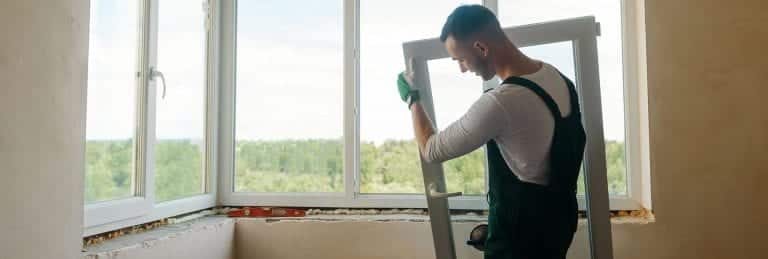How to Replace Rotted Wood Around Window

Even if you know the best way to clean a glass window, if the structure supporting it is weak and unstable, it won’t be long before it’s damaged. And considering most windows have wooden frames, they require extra maintenance. While wood is one of the oldest and most reliable construction materials, its organic nature puts it at risk to the elements, particularly when it comes to wood rot. This proves especially true in wet climates. Rot sets in when moisture enters the wood and doesn’t have a chance to dry out.1
One of the most common places for rot to set in is wood around windows, especially on the windowsill.
Once you have a rotted windowsill, it opens up your home to a slew of other moldy issues, making wood window rot repair one of the most common window-related repairs homeowners must tackle.
Read on to learn how to replace rotted wood around a window sill.
Identifying Rotted Wood Around a Window
Sometimes, rotted wood is obvious. Most often, the rot will occur at the bottom corners of the window near the sill. If the wood appears cracked, crumbling, and generally falling apart, the rot has probably set in, and work will need to be done.
Another indicator is discolored or peeling paint on the wood around the window.2
If you can’t visibly see rot but suspect it’s present, you’ll need to probe the wood to know for sure. Grab a screwdriver or pointed instrument and press around the wood you believe may be rotting. Healthy wood will feel hard, whereas rotting wood may feel spongy and crumbly.
Once you’ve identified rot in the wood, start the process of window wood rot repair in one of three ways:
- Fixing the rotted wood with epoxy wood filler. This is a great option to use if most of the wood is intact, and you can remove the damaged section. This method should be used if less than 20% of the board is rotted.
- Replacing the rotted wood. This method is slightly more involved and will need to be used if more than 20% of the wood is rotted.
- Replacing the window entirely. Does the job look too extensive to tackle yourself? How do you know when to replace the window? Consult with a professional and price out the difference between window repair and window replacement.
Assessing the Extent of the Rot
How do you tell the percentage of wood that’s rotted?
You’ll need to assess the level of damage.
Continue using that screwdriver (or pick up a construction chisel) and feel around the rotted wood to find the perimeter of the damage. This will be identified as the area where the wood moves from spongy to hard. You should then scrape out whatever rotted wood you can by hand.
There is usually more rot just under the surface. Once you’ve scraped away the top layer, you’ll have a better visual of how much damage there is so you can expand your perimeter accordingly. Always make sure to feel around the entire board, so you don’t miss any additional trouble spots.
If you’re uncomfortable embarking on this journey, take that as a sign to call in some professional help. In the next section, we’ll continue to describe the three methods for addressing rotted wood. Use this information for a DIY fix or prepare yourself for a conversation with a qualified window repair professional.
Method 1: Fixing with Epoxy Wood Filler
Let’s start with the simpler epoxy fix. First, you’ll need a few items at your disposal:3
- Construction chisel
- Putty knife
- Epoxy wood filler
- Paint (matching colors) and paintbrush
- Sandpaper
- Gloves and a facemask
Step 1: Create a Clean Gap
Once you’ve identified the edges of the rot, use your chisel to scrape the rotted wood away. Deep rot can be rooted out by hammering the chisel to break deeper into the wood. Repeat this process until you’ve removed all the rotted wood. You should be left with a clean gap where only healthy, dry wood remains.
Step 2: Prepare the Epoxy
Epoxy wood fillers often give off harsh fumes, so it’s time to put on your gloves and facemask. Once you’re gloved up and ready for wood surgery, you should follow the directions of the back of the epoxy package to mix the components.
Pro-tip: It’s easiest to mix the epoxy components on top of a non-stick surface like wax paper or a freezer bag.
Step 3: Apply the Epoxy and Let it Cure
After you’ve mixed the solution, use your putty knife to scoop the epoxy into the gap you created in the wood. Try to keep the epoxy as flush to the rest of the wood as you can while ensuring you’ve filled the gap.
Once you’ve filled the gap, it’s time to let the epoxy cure. Check the instructions on the back of your box for curing times. This may take up to a few hours.
Step 4: Sand and Paint
Epoxy expands slightly while curing, so once it’s dry, break out the sandpaper and smooth down the excess solution until it’s flush with the surrounding wood. You will be able to tell you’re done sanding when the only difference between the new epoxy filler and the original wood is a color difference.
Now, you’re just about finished. Pop that can of paint open and give the wood a couple of fresh coats of paint. Once the paint has dried, your window will be good as new.
Method 2: Replacing the Entire Board
If the wood around your window is severely rotted, patching will not provide a long-lasting fix, so it’s time to replace the board. This method is slightly more involved and requires basic carpentry knowledge.4
You’ll need a few tools and items to make the fix:
- Lumber for the replacement
- A saw
- A drill or hammer
- Wood screws or nails
- Tape measure
- Wood putty
- Pry bar or clawed hammer
- Caulk
Step 1: Remove the Rotted Board
Now that you’ve decided it’s time to replace the whole board, pull out the pry bar or clawed hammer. Use the tool to pry away as much rotted wood as you can from the window. Next, you’ll want to pry the remaining board out. It’s often best to insert the clawed end of the bar into a corner, then press it against the healthy wood, creating leverage until the rotted board dislodges from the window.
Work carefully at this step to minimize damage to surrounding boards and to the window itself.
Step 3: Seal Breaks in the Sheathing Underneath
At this point, you’ll have a whole new perspective on the interior of your window. Windows are surrounded by a sheath that prevents water from getting into your home. If you see cracks or breaks in the sheathing around the window, use your caulk to seal it. Simply caulk line across the sheath, flatten it down with your finger, and allow it to dry. This measure will be important in preventing additional moisture from leaking in.
Step 4: Measure the Rotted Boards
Use your tape measure to measure the rotted boards you’ve removed. You’ll want to take into account the length, width, and height. Be as exact as you can—this will ensure the most accurate measurement for your replacement board.
Step 5: Buy a New Board and Cut it to Size
Shop around at your local lumber supplier for a board that fits as close to the dimensions you measured. Lumber is sold in uniform dimensions, so you should be able to find something with identical width and height.
Once you’ve got a new piece of wood, it’s time to prepare it to be cut. Use your tape measure again to correctly mark the precise length measurement you took from your rotted board. You’ll then use your saw to cut the board.
During this step, wearing a safety mask is recommended. Power saws spit sawdust, which can be damaging if caught in your eyes or inhaled into your lungs.
Pro-tip: If you’re not in the mood for a little DIY carpentry or don’t have a saw, the lumber seller will often be able to cut the board for you for a small price. Give them the dimensions, and they will take care of the rest.
Step 6: Check the Fit
With your freshly cut lumber, insert the wood into the empty slot around your window to ensure it fits properly. If it’s too big, you may need to make a slight trim to the wood. If it’s too small, you’re not totally out of luck—you may be able to fill the excess gap with epoxy wood filler (see method 1).
Once the new board is in the empty slot, gently tap it with your hammer to ensure it fits flush with the surrounding wood.
Step 7: Drill or Hammer the Board In
Assuming everything fits according to plan, use your drill and wood screws to drill the board into the home. If you don’t have a drill, you can use a hammer and nails to secure the fresh board.
Step 8: Paint and Caulk the New Board
You’re just about done. First, use the caulking to seal gaps between boards and prevent future moisture from getting into the home. Finally, use your matching paint to put a few coats over the board. Let it dry, and you’re complete.
Method 3: Window Replacement
With any luck, your windows have a small area of rotted wood that you can easily repair or replace on your own (or with a little help from a professional).
But before you break out the toolkit, run the numbers on the total cost of your repair versus a replacement.
After all, new windows can come with myriad added benefits, including:
- Increased energy efficiency and lower energy bills
- Zero risk of leaving behind rot and its potential health hazards
- Improved home value
If new windows are on your home improvement list, your rotted wood might be a sign that it’s time to make them priority number one.
Choose the Best Window Repair Course with Glass Guru
Learning how to fix or how to replace rotted wood around a window sill can provide your home with years of lasting moisture protection.
While a crafty DIY specialist can do the job (depending on the extent of the damage), it doesn’t have to be a project you tackle alone. Glass Guru is happy to help. Our network of qualified, local window repair professionals have one priority—helping you find the best course of action for your wallet, comfort, and your home. We can also help you find a professional that knows how to repair different types of glass partition if you have any at your home or establishment.
Request a free consultation to get a better sense of window repair and replacement options and say goodbye to rotting windows without a single trip to the hardware store.
Sources:
- Sleeping Dog Properties. What is Wood Rot?: Key Things to Know https://www.sleepingdogproperties.com/perspectives/what-is-wood-rot/
- Home Improvement Scout. How to Replace Rotten Wood Around A Window? https://homeimprovementscout.com/how-to-replace-rotted-wood-around-window/
- WikiHow. How to Replace Rotten Wood Around A Window. https://www.wikihow.com/Replace-Rotted-Wood-Around-a-Window







